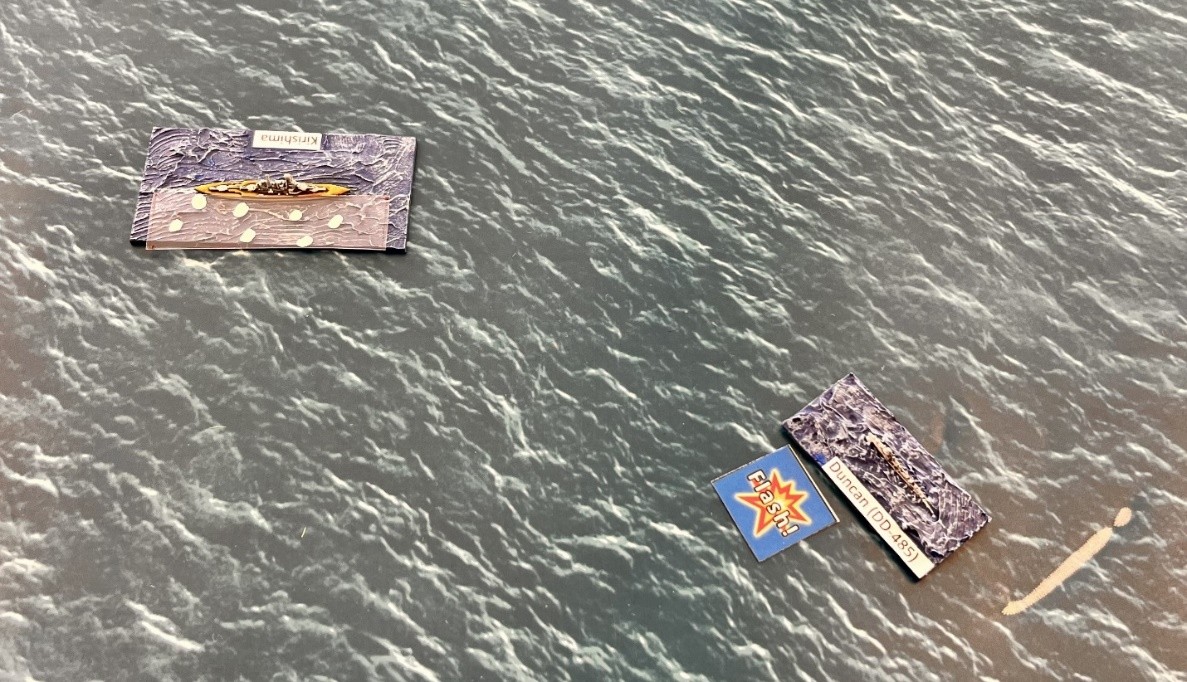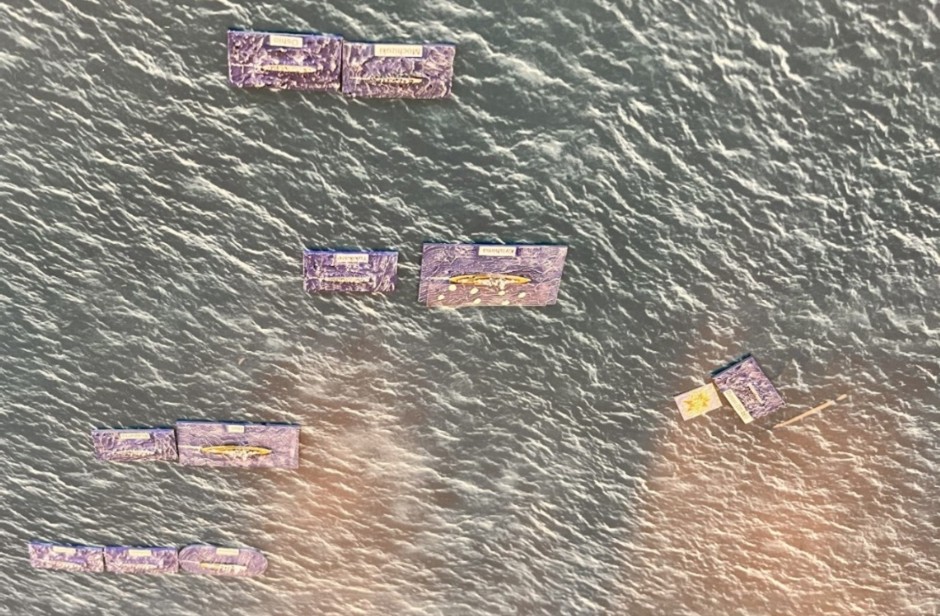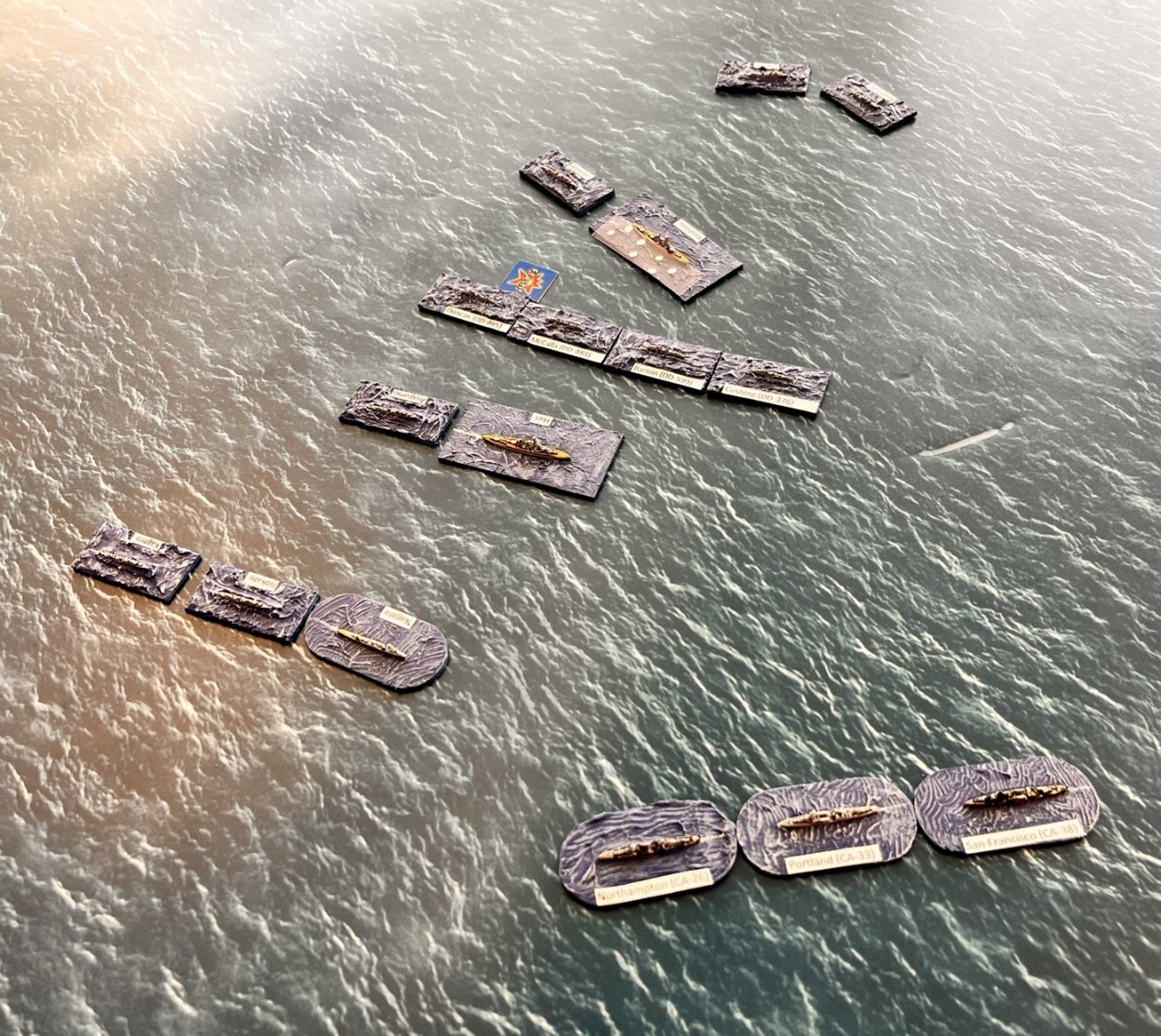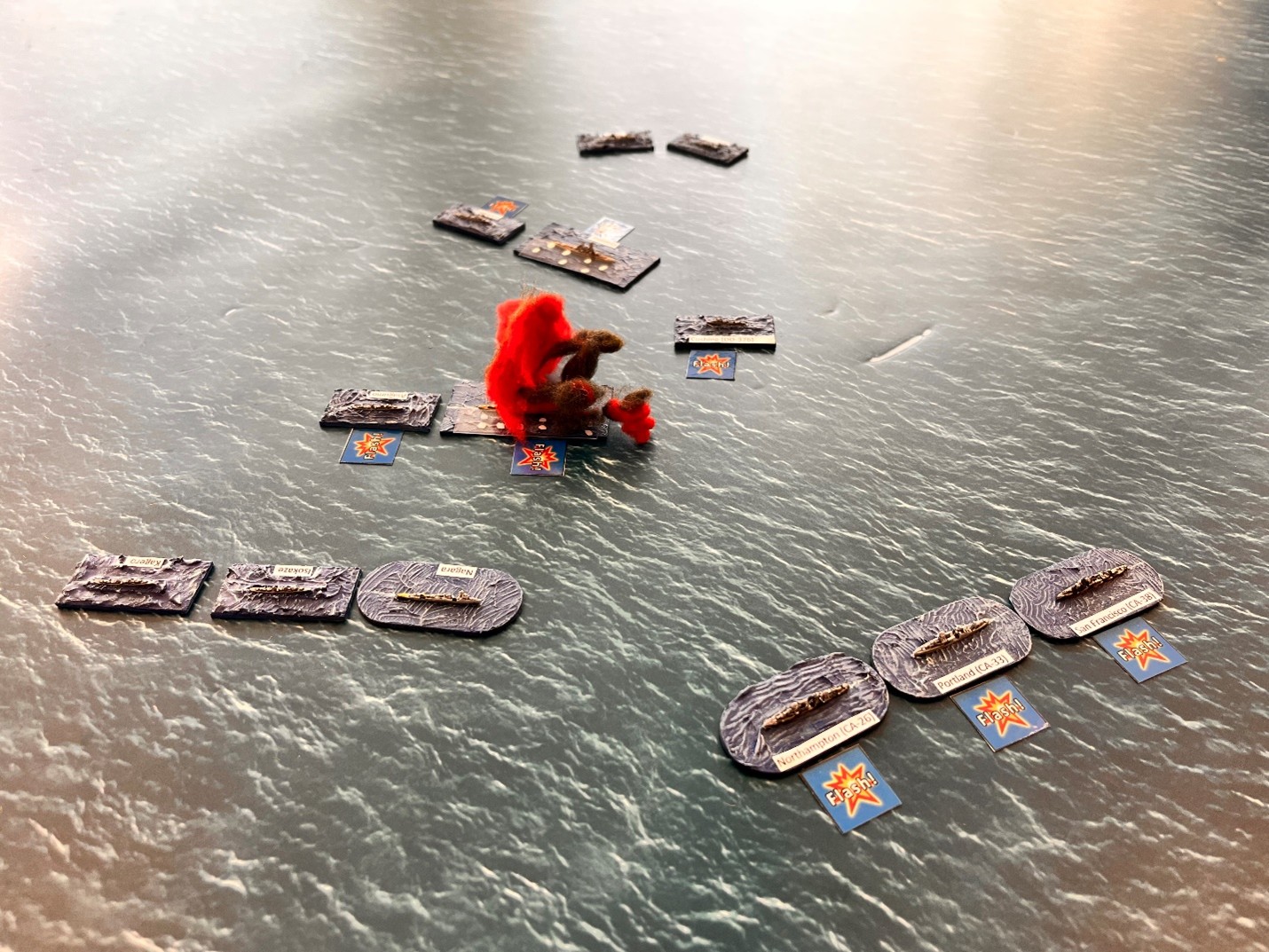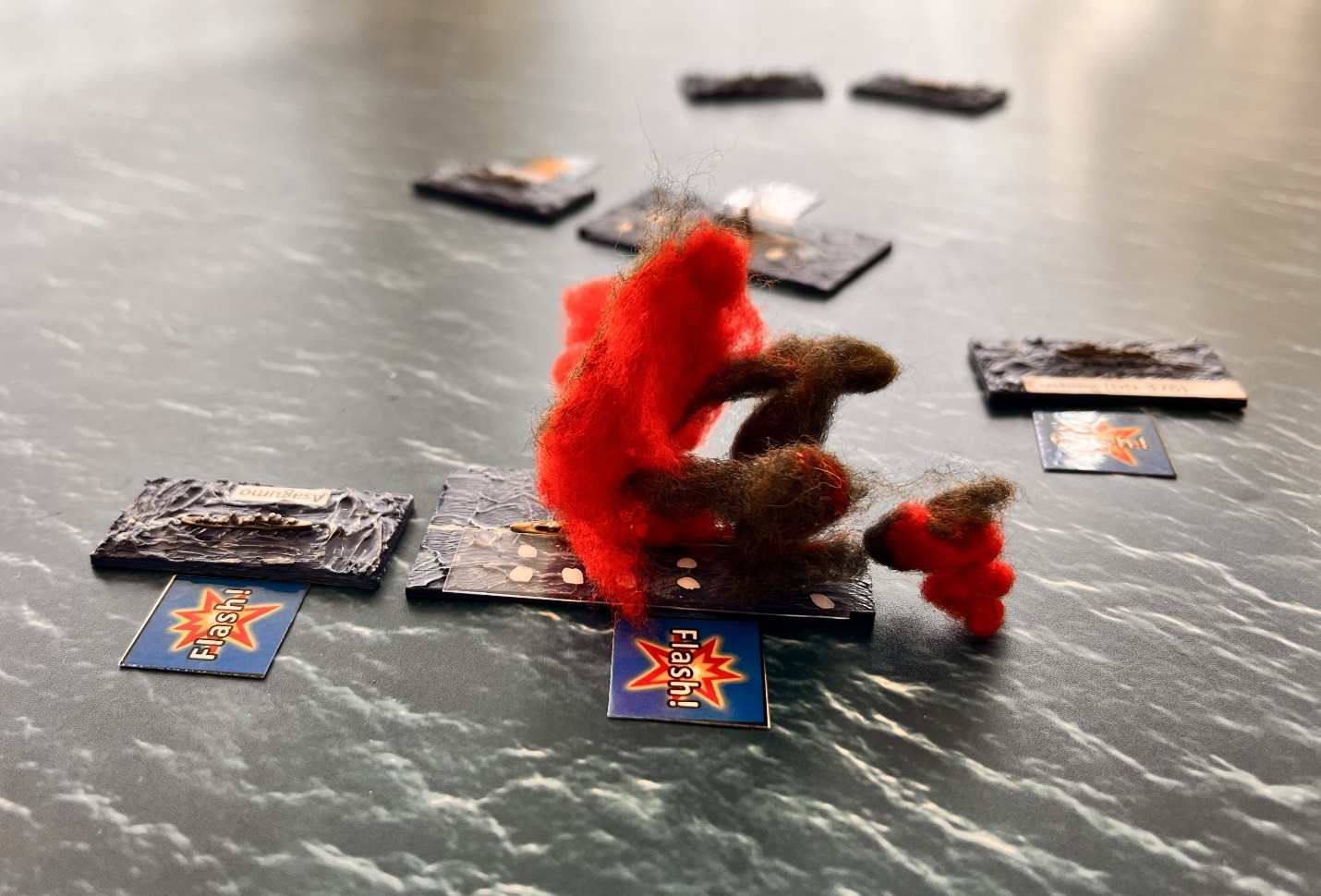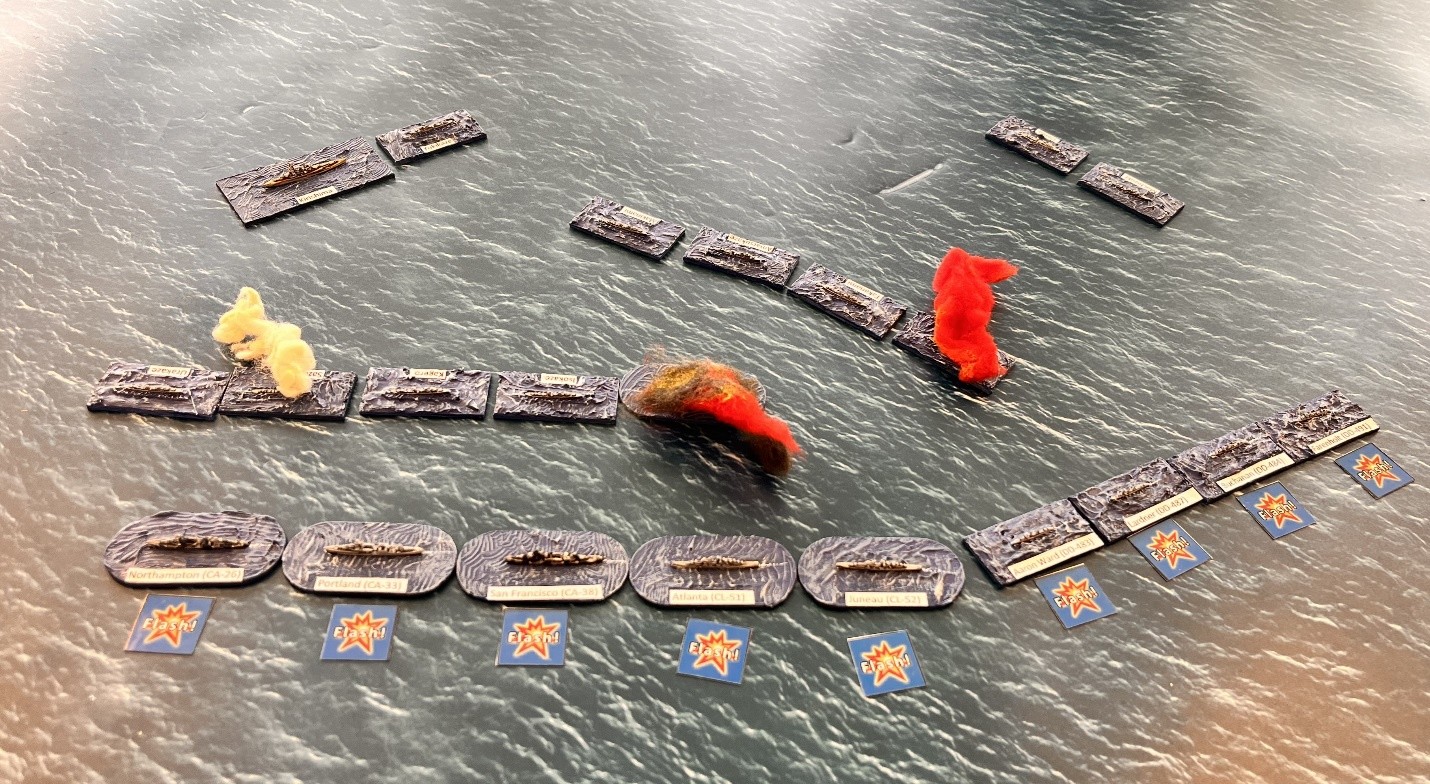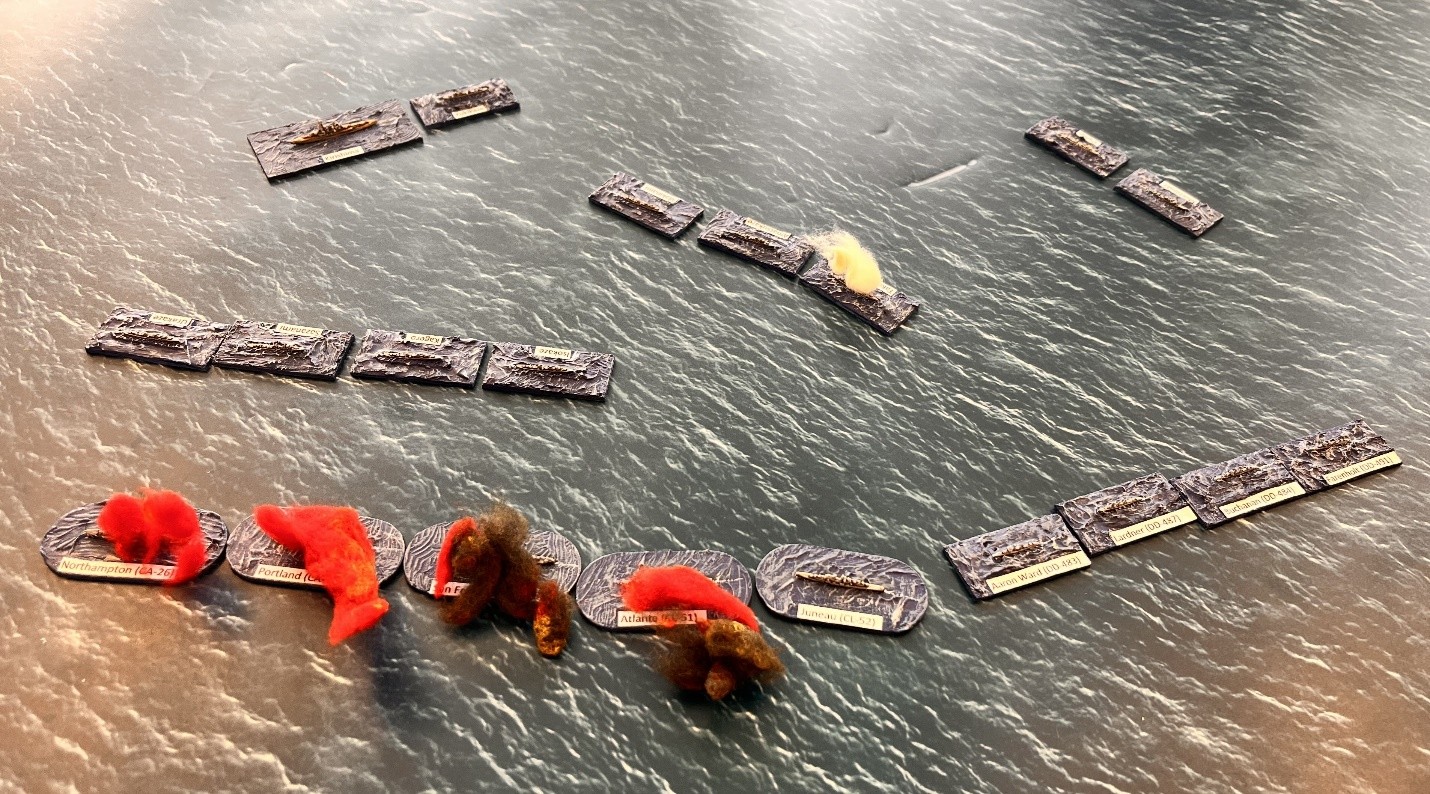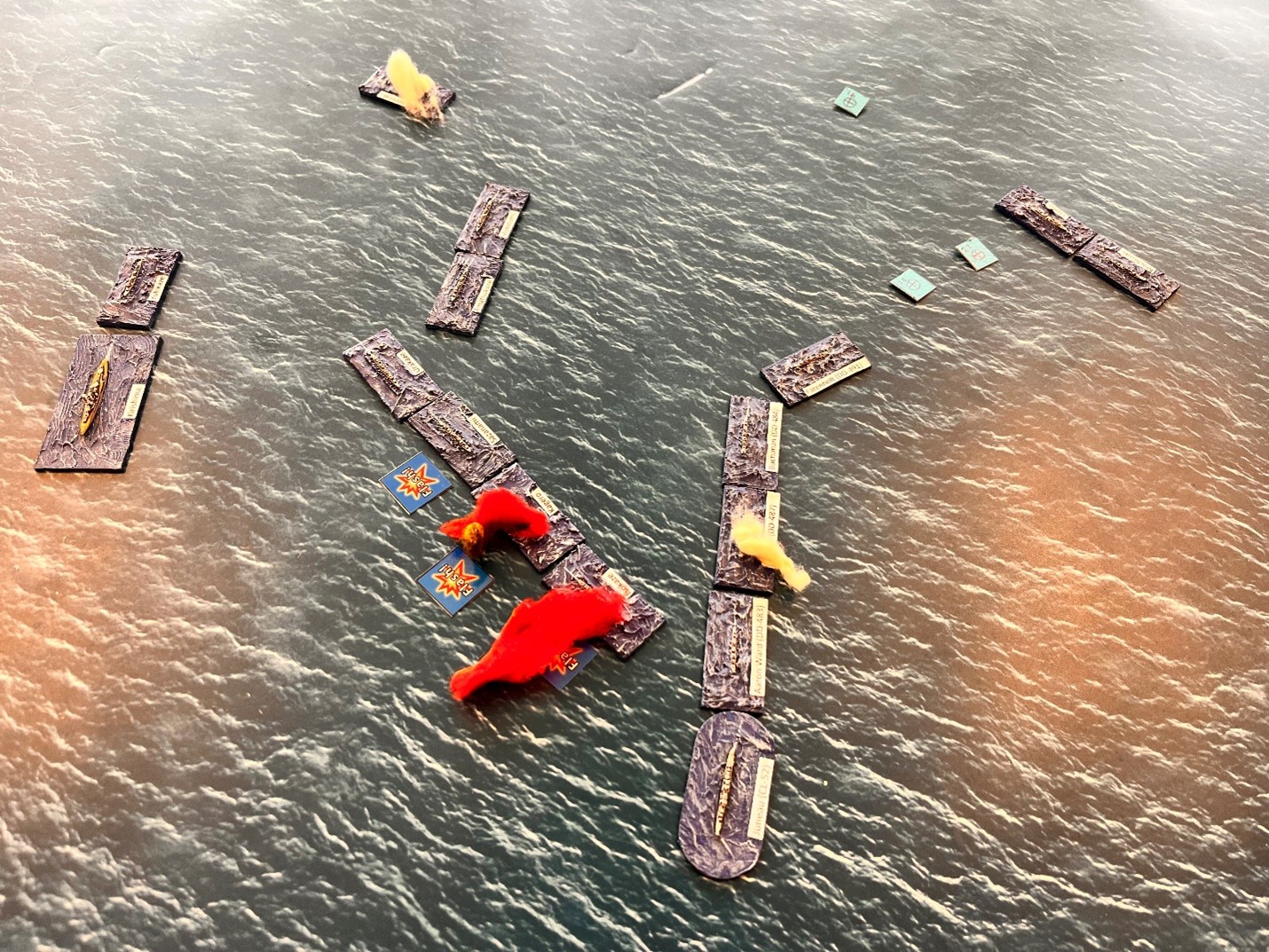|
|
|||||||||
|
|
NINE FATHOMS DEEP IN IRONBOTTOM SOUND
The First Naval Battle of Guadalcanal Re-fought with “Nimitz” Rules
By Peter Hunt
0142hrs: “Enemy in Sight! Red Oh Two Oh. Range 3000.”
“Illuminate with Star Shell!”
The Set Up
Readers of my review
of Sam Mustafa’s WWII naval rules “Nimitz” will know that I consider
them a flawed masterpiece. I use that artistic description
intentionally, for in a more perspicacious, and much shorter, review
than mine Charles Vasey, for whom I have always had massive wargaming
respect, uses an artistic analogy that the rules take an ‘…
impressionistic approach (“We paint not light, but the impression of
light”)... ´ His phrase struck a chord with me because, as a lad, when I
was not wandering around the Cardiff Central Library ascertaining the
barbette armour of HMS Anson, I was wandering about the National Museum
of Wales which has a marvellous collection of Impressionist art. One of
the important things about Impressionism is that it is not abstract.
Monet might have painted Rouen Cathedral over 30 times each with a
different impression of light, but each time he painted it the subject
was still, clearly, a cathedral.
Putting my money where my mouth is I had already
drawn up a draft set of amendments to see if we could cure Nimitz of
what I considered its flawed bits, named, from the other side of the
pond, “Cunningham,” (included here in their final form, not the interim
version used in this playtest.) Get the midshipman to bring you a nice
hot mug of naval cocoa - Kai, (or Kye, spellings vary,) peruse them, and
feel happy to use any that you see fit.
[hyperlink to follow.]
The major changes include halving the length of
the turn, revising the torpedo and night-fighting rules, enhancing the
special effects, and minor changes to the gunnery. The changes seemed
sensible, but did we still have a work of art? And just as importantly,
could we still see the cathedral? A playtest was in order, and it is
always my belief that if you want to find out if a set of rules is up to
snuff, then a historical playtest is in order.
Tony, with his usual speed and efficiency, (I’m
sure he has a sweat shop in his back room, no one can possibly paint
stuff as quickly as he does,) had produced both sides for the Battle of
Midway in 1:6000 scale using Figurehead miniatures and Litko bases. This
enabled me to put together the historical OB for the First Naval Battle
of Guadalcanal on 13th November 1942. All the class types were correct
except that Tony didn’t have a Brooklyn class “machine gun cruiser” so
the CA Northampton had to impersonate the CL Helena. Out of the 27 ships
in the battle 16 were as named and the other 11 were represented by
ships of the same class, so I have used the latter’s new names in this
account rather than the original historical names.
Tony played Rear Admiral Daniel J. Callaghan
commanding Task Force 67 consisting of two heavy cruisers, three light
cruisers, and eight destroyers. Bill was Vice Admiral Hiroaki Abe with
two fast battleships, one very light cruiser, and 11 destroyers. In
Nimitz points values the Americans had a 10% advantage with 107 points
against 98 Japanese. This was only Tony’s and my second Nimitz game, and
Bill had never played before, so it was a good test to see if we had
retained the simplicity and playability of the basic Nimitz rules whilst
enhancing their historical accuracy. I don’t think that either admiral
knew enough about the historical action to affect their responses,
indeed Bill’s favourite feature of the Guadalcanal Campaign was that
when HMNZS Kiwi rammed the Japanese submarine I-1 the Japanese officers
replied with swords. Clearly there would be no lack of samurai spirit
from a man of such tastes.
The Game
Both sides received a historical briefing. It was
a dark night that had seen heavy rain, with no moon. Visibility was
about 3,000 yards. The south side of the table was the northern coast of
Guadalcanal, and thus impassible. Abe could form his squadron into three
columns. His aim was to reach the south-east corner of the table whence
he could bombard Henderson Field. To this end his two battleships had
their guns loaded with, and their ammunition hoists full of,
“Sanshikidan” air-bust shrapnel ammunition. Whilst very effective
against planes and unarmoured structures these shells were much less
effective against armoured targets, and it would take several salvoes to
fire them off before the guns could reload with armour-piercing rounds.
Because of a heavy rainstorm Abe had circled his squadron to use up time
and let the rain squall precede him so that he could bombard Henderson
in the clear. Abe had put is squadron into three parallel columns, one
with the light cruiser Nagara leading the battleships Kirishima and Hiei
(flag), followed by destroyers in the centre; and then a column of
destroyers on either flank.
Bill chose three columns of destroyers,
with the columns led (from south to north) by Nagara, Hiei and
Kirishima.
Callaghan’s Flagship San Francisco had been hit in
a bombing attack the day before and had suffered structural damage and
had its radar knocked out.
A Japanese attack that night was
anticipated, but it was not known whether this would be directed on
Henderson Field as had happened a month earlier; or against the American
supply ships that had sailed east from Guadalcanal that evening; or be
in support of a troop landing. Callaghan had to guard against all three
possibilities. With limited command and control capabilities, doctrine
required Callaghan to field TF 67 in one column. Callaghan put
destroyers in the van and rear of his line, with the cruisers in-between
and the San Francisco (flag) in the centre. Tony did the same.
Thus, in the early hours of 13th November 1942,
four columns of ships were sailing on parallel courses off the coast of
Guadalcanal. The Americans were closest inshore, heading north-west,
whilst further out were the three Japanese columns led by Nagara, Hiei
and Kirishima respectively, heading south-east. With no radar on his
flagship Tony was reliant on the other radar equipped ships of his Task
Force to see for him – a most inefficient arrangement. It was Helena who
gave the first warning, reporting a contact 14 miles off her starboard
bow at 0124hrs. Whilst Tony was digesting this information the other
radar ships reported their own contacts, but blocking each other’s
transmissions on the Talk Between Ships, (TBS), and giving relative
bearings rather than true ones, which without a Combat Information
Centre to collate and plot all this information left Tony with little
more spatial awareness. With the contact closing at a mile a minute,
(and we were using six-minute turns) Tony ordered a starboard turn for
his line to the north which would “cross the T” of the contact.
Callaghan has done the same.
For his part Bill had no radar to tell him what
was in the offing, but he could trust to his squadron’s superior optics,
hand-picked lookouts, and well-drilled night-fighting skills to give him
the edge and sight the enemy before the enemy sighted him. But a
battleship is a much bigger target to see on a dark night than the lead
American destroyer, so their sightings were almost simultaneous at
0142hrs. A rather shocked USS Ducan reported a battleship 3,000 yards
away and was ordered to illuminate the target with star shell.
The refight of the First
Naval Battle of Guadalcanal had begun.
With his advantages in night-fighting Bill was well placed to win, and
go on winning, the initiative. But having done so he was faced with the
Nimitz dilemma of moving first or second, and thus giving the enemy the
chance of reacting to his moves, and then firing first or second, when
firing second may be too late. He had no idea what the enemy forces were
but had clearly put his battleships to the fore for a reason, so opted
to swallow the disadvantage of moving first for the promise of shooting
first.
0142hrs: The Plot Thickens (See what I did there?) Duncan has illuminated Kirishima. The situation before the Japanese move. Admiral Abe realises that his formation is not as neat, nor compact, as he had thought . . .
Normally in Nimitz sides alternate moving
individual ships or groups of ships, starting with the slowest and
progressing to the fastest. Since in this first on-table move all ships
happened to have the same speed on and the Americans were in one, still
predominantly unseen, group, I put my umpire’s cap on and got both
admiral’s intentions before moving what ships could be sighted for them.
It was only now that Bill realised that his neat formation, with three
columns advancing on a level front, had been disrupted when he had
performed that loop in the rain squall and had broken up into four,
unevenly spaced columns with Kirishima well to the fore. (Abe had faced
a similar problem). Nothing daunted the Japanese turned to engage and by
closing the range sighted three more American destroyers behind Duncan.
0148hrs, the Japanese turn to engage and sight McCalla, Barton and
Cushing behind Duncan. The Americans only have sight and firm radar
tracks on the heads of the Japanese columns, in the darkness and
confused radar echoes are five more unseen Japanese destroyers.
To Tony it appeared that he had a numerical advantage with 13 ships to
nine, so a close-range knife-fight seemed a good proposition. The
leading American destroyers could have turned away, but Tony threw them
into the melee just as Callaghan had done before him. Unlike Callaghan,
who followed his destroyers with his cruisers in-between the Japanese
columns, issuing the unusual order: "Odd ships fire to starboard, even
ships fire to port” Tony turned his cruisers sharply to port to bring
their starboard arcs to bear on the Japanese outside column.
0148: Before the Guns Speak
Duncan has led the American destroyers in between
the Hiei’s (flag) and Kirishima’s columns. If the destroyers survive
they will be well placed to end the battle in six minutes with torpedo
attacks on the Japanese battleships. To the south the 6” cruiser Helena,
(portrayed here by Northampton,) followed by the 8” heavy cruisers
Portland and San Francisco (flag) can engage the Nagara but cannot see
Hiei. Behind the San Francisco are two more light cruisers and four
destroyers, as yet unseen by the Japanese.
Bill’s decision to move first and thus fire first seemed to pay off. In
the real action some of the American destroyers had passed so close to
Kirishima that the battleship could not depress its guns enough to
engage them. On the other hand, the destroyers were too close to use
torpedoes. In this re-fight the three lines were separated by at least
1,000 yards each, so the battleships had clear shots, but any surviving
destroyers would have perfect targets for their, albeit very unreliable,
torpedoes.
There was to be no torpedo attack. In Nimitz both
sides alternate firing individual ships or groups of ships. Hiei and
Kirishima opened-up with their 6” secondaries and then Kirishima and her
consort destroyer added their 14” and 5”, to boot.
Duncan was crippled and McCalla sunk by
this onslaught. In reply the plucky Cushing hosed Kirishima’s upperworks
with 5” shells, damaging her directors which would debilitate her fire
for the rest of the battle. As the other Japanese groups joined in,
Ducan was finished off, Hiei sank Barton, and Nagara zeroed in on
Cushing’s gun flashes and sank her. The battleships’ Sanshikidan shells
would have been deficient against armoured targets, but they were more
than adequate to deal with the “tin can” hulls of the destroyers.
0148hrs: The Battle Opens Well for Abe
Duncan is crippled and McCalla sunk. Barton and Cushing have replied
with their 5”. Hiei and Nagara are about to finish the job.
From Callaghan’s column only the lead ships of the Nagara column were
initially in sight, but when Hiei opened-up with her secondaries the gun
flashes gave the American cruisers an aiming point and they used their
own 5” secondaries to illuminate the battleship with star shell. (So,
there can be benefits to firing second). As the star shell hung over
Hiei like chandeliers, the three cruisers had a clear target and all
shot well. Helena struck Hiei’s forward barbette. At this range there
was an outside chance of a 6” shot penetrating the 10” of armour – but
it was not to be, and the shell inflicted little damage. Portland struck
Hiei’s superstructure and knocked out her main director. But, when San
Francisco fired that strange magnetism that attracted Helena’s fire was
still working, and another hit on Hiei’s magazines was scored – this
time the 8” shell punched through, (it was about 5,000 yards away and
could have gone through 10” of armour at 9,000 yards.) So ended the
Hiei’s and Admiral Abe’s participation in the battle.
0148hrs: That Strange Magnetism. Abe’s Battle Ends Abruptly
“The Hiei’s Gone…”
“…Where?”
Word of the loss of the flagship was passed
through the Japanese squadron with a sort of whispered incredulity and
was received with incomprehension by those below decks who had not
witnessed the explosion. In game terms, with Abe nine fathoms deep in
Ironbottom Sound[1]
the Japanese command and control problems had cancelled out their
night-fighting advantage for the initiative test, and the Americans now
held a marked heavy gunnery superiority. For the only time that night
Tony won the initiative and, with his line in perfect order opted to
move first to maximize his gunnery advantage by shooting first.
As
the groups on both sides alternated movement and emerged from the
darkness into the flames and the smoke of battle, for the first time
both commanders were finally able to judge the odds against them. The
Americans still had two heavy and three light cruisers, plus four
destroyers, the Japanese one battleship, one light cruiser, and 11
destroyers. 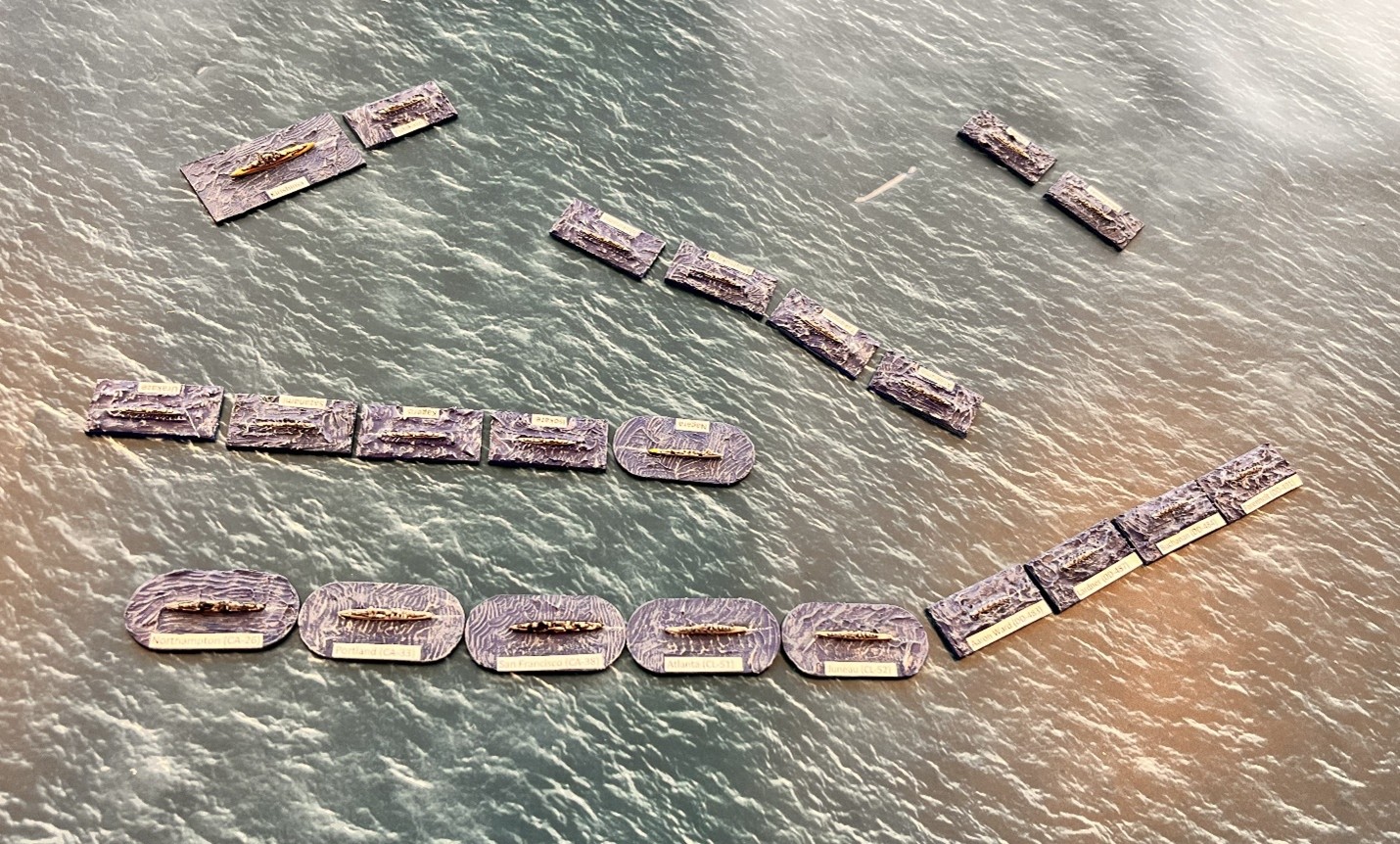
0154hrs: Before the Deluge
The American line at the bottom is led by five cruisers, followed by
four destroyers. At the top left Kirishima has reversed course to
avoid being a torpedo magnet for the American destroyers, whilst the
light cruiser Nagara (almost dead centre, leading the bottom
Japanese column,) and ten destroyers sail into harm’s way.
Tony issued the clear, if a trifle redundant,
order: “All ships open fire to starboard!” The Americans were in a
perfect gunnery position, with all their “A” arcs open and two
Japanese columns within 2-3,000 yards. Eighteen eight-inch, 15
six-inch, and no less than 60 five-inch, (almost half of which were
contributed by the 14-gun broadsides of the light cruisers Atlanta
and Juneau,) guns belched forth their broadsides. Against this the
Japanese could only initially bring to bear 6 six-inch and 36
five-inch guns, with a handful of five-inch joining in later firing
at the Americans’ gun flashes. San Francisco and Atlanta smothered
the light cruiser Nagara with fire and sank her, the American
destroyers dispatched the destroyer Asagumo leading the second
Japanese column; and Helena and Juneau, (first and fifth in the
American line), set their opposite numbers on fire, and others
received lighter damage. When the surviving Japanese ships tried to
return the compliment they had little obvious effect, although a 5”
shell exploded in Helena’s boiler room intakes temporarily reducing
her speed.
0154hrs: Broadsides! Commence, Commence, Commence!
Ninety-three American guns pour fire into the Japanese lines.
Nagara and Asagumo leading the Japanese columns are sunk, Sazanami
and Takanami, (the latter not yet marked,) are set on fire. Others
are damaged but not crippled. It is a tribute to the way that the rules were playing that both Tony and Bill had fully entered into the spirit of this rather strange, decidedly hectic, and disturbingly sudden-death, night action. The Americans had, as is their wont, taken guns to a knife fight. If the point-blank exchange of gunfire continued like this there would be little left of the Imperial Japanese Navy. For their part the Japanese were out to prove, as is their wont, that the battle was still a knife fight, to be decided with knives, or at least Long Lances. It was not difficult to imagine the Japanese destroyer commanders turning their eyes from the sight of Nagara being destroyed ahead of them, brandishing their swords, pointing right, and ordering their 24” torpedo tubes to train to starboard…
The Type 93 torpedoes were still pretty much
of a mystery to the USN at this stage in the war, but what mattered
most in this engagement was not their long range, but their high
speed and heavy warheads.
Fired from the optimum position –
forward of the target’s bow but not in a small aspect - eight
quadruple spreads of Long Lances closed the American cruisers at a
combined speed of over 70 knots, and stopwatches on board the
Japanese destroyers were set for 80 seconds.
0201hrs and 20 seconds: The Night of the Long Lances
From left to right Helena, Portland, San Francisco, and Atlanta are
cut down by 24” torpedoes.
From the bridge of the Juneau, the fifth ship
in the American line, it seemed as though the Pacific Ocean has
erupted in a paroxysm of explosions and fire, as every ship ahead of
them had their backs broken by the Long Lances. Admiral Callaghan
joined Admiral Abe nine fathoms deep in Ironbottom Sound. Further
down the battle lines more destroyers were adding yet more “fish” to
the mix, with the Americans targeting the damaged Takanami, and the
Mochizuki aiming at the Aaron Ward.
These torpedoes would take six minutes
to run, and that night in Ironbottom Sound a lot could happen in six
minutes.
Putting her helm hard to port Juneau led the
American destroyers south towards the coast of Guadalcanal, hoping
that the Kirishima would not follow, but the Japanese had the bit
between their teeth and turned south too. The American gunfire was
still potent, Juneau and Aaron Ward sank
Isokaze, and Buchanan sank Kagero. But Juneau’s gun flashes
disclosed her position to the Kirishima, which, firing by local
control, exhibited remarkably good shooting in these debilitating
circumstances and brought down a hail of 14” shells on the light
cruiser, crippling her.
0205 hrs The Run South
American gunfire sinks Isokaze and Kagero, but Juneau, exposed by
her own gun flashes, is targeted by Kirishima on the extreme left.
The blue datum markers show where the Japanese and American
torpedoes were lunched from five minutes ago. They still have 60
seconds left to run. On board three destroyers men watched as, with what seemed to be agonizing slowness, the hands of stopwatches and chronographs ticked down the seconds from 360 to zero. From the south there came a flash, followed 25 seconds later by the sound of a crashing explosion as the USS Aaron Ward disintegrated. To the west there was no flash and no sound. The chronographs ticked on – 390 seconds, 420 seconds – the American torpedoes had missed. (In game terms torpedo shots at these ranges and aspects had only a 1-in-6 chance of hitting, so with four American and two Japanese spreads in the water only one hit was par for the course. But, again, the torpedo gods had chosen to smile on the Japanese this night).
As
the torpedoes sank to the bottom of Ironbottom Sound the guns
continued to thunder in a final paroxysm of death and destruction as
both sides ran south towards Guadalcanal. USS Farenholt sank
Urakazi, and, for the last time that night, Kirishima found her
target and sank the Lardner. By now however Kirishima was
approaching the five-fathom line – a matter of some concern since
she drew 31 feet of water. Bill turned north-west, and Tony
south-east. Just after 0212 hrs the refight of the First Naval
Battle of Guadalcanal had ended.
Some Conclusions, Some Thoughts, and Some Tweaks
I was a very happy little bear….
The rules amendments had worked well, I think Bill and Tony had had
a good time, (or as good a time as you can have when you have four
cruisers shot out from underneath you in one turn), and although the
refight was different to the historical fight we had not exceeded
the bounds of historical possibility and nothing ahistorical had
reared its ugly head.
The real battle had lasted about 40 minutes
and our seven turns added up to 36 to 42 minutes, so spot on there.
This had taken about two and a half hours of play, so about 20
minutes a turn. This is slower than the “real time” aimed for in the
Nimitz RAW, i.e. a 13-minute game turn played out in about 13
minutes, but it is difficult to see how this historical match-up
would have worked with the RAW at all. Both sides would have been in
clear vision at 13,000 yards, (12”). There would have been no
deductions for gunfire effect, although there would have been fewer
chances to fire. Torpedoes would have been (even more) devastating,
hitting instantly at 12” with no deductions for range. With both
sides closing the 12” sighting distance at a maximum of 24” a turn,
(in fairness, more practically a 16”+ closing speed), anything still
afloat after the first turn would have passed the opposing ships and
spent the next two turns to turn 1800 to re-engage. It
would have been quick, and very bloody, and could well have been all
over in real time of three 13-minute turns played out in 40 minutes.
But it would probably not have had the historical feel, nor given
the satisfaction of the revised rules. The revisions are aimed at
maximizing Nimitz’s good points – interactive movement with no
pre-plotting, and a clean, innovative, gunnery system – whist doing
away with some of the simplifications that reduce the game to a
dice-fest of bumper cars at sea. As it was, with the revisions, Bill
and Tony were constantly being called upon to make interesting
decisions about what to do and how to do it, and that, to me, is the
essence of a good game.
We had a higher casualty rate than the real battle, but that is not
unusual in wargames. Yes, by halving the move time, and adding the
point-blank rule, (and a lot of this game was fought at point blank
range because of the nature of the historical battle,) the
effectiveness of gunnery has been increased over the RAW, but I
think that the two main contributory factors to the ship-killing
were the lack of confusion, and the torpedoes.
Confusion is hard to do in a wargame, unless you want it to descend
into random anarchy, which might be accurate, but is not much of a
game. We were playing in an air-conditioned room, after a nice lunch
with a bottle of wine. Most of the ships were in clear view, even
though they were not within “sighting” distance of each other, and
they would always go where they were ordered to go. To model the
confusion of the real battle I should have put Tony in a dark metal
box, hit the outside with sledgehammers, fired strobe lights in his
eyes, let off fireworks near his trousers and had him shout out
orders to ships from memory of where they were supposed to be.
Appealing as so torturing Tony in pursuit of wargaming excellence
this might be, the more practical wargaming answer is to tweak the
rules to add a bit more confusion by catering for friendly fire, (a
continuing factor in Pacific night actions right up to Surigao
Strait, in our historical battle, for example, San Francisco
clobbered Atlanta), derelicts, and collisions. There would be more
hazards to navigation if there were less ships sunk immediately, and
more ships becoming stopped or manoeuvring erratically to break up
the neat groups. This brings us to the torpedo effects.
The power of the Long Lances to sink ships
immediately is not a rules accident. Mr Mustafa discusses this on
page 36 of the RAW. As the rules stand, they have a 50% chance of
immediately sinking a heavy cruiser, a 66% chance of sinking a light
cruiser, and will automatically sink a destroyer. So, on this basis
Bill’s performance of sinking three out of three heavy cruisers,
(Helena has the same protection as a heavy cruiser,) amounted to a
one-in-eight chance, difficult but far from impossible. The odds
were further stacked against Atlanta, and once Aaron Ward was hit
she had no chance of surviving.
Unfortunately, the real-life odds do
not stack up that way. This list gives combat damage to American ships in WWII and from it you can extract the ships hit by surface launched Japanese torpedoes. If you want to be more complete you can add in the ABDA ships that suffered the same fate, (one heavy cruiser, three light cruisers, and some destroyers).
Of the 11 heavy cruisers, (including Helena
and Exeter,) hit by Long Lances, only three were sunk immediately,
three others were eventually sunk taking between 50 minutes and
three hours to go down, (I include Exeter in this, as rather like
Bismarck she was in the process of scuttling herself when the
torpedoes hit,) and five survived.
Of the five light cruisers, (including
three ABDA ships,) two sank immediately, one took three hours to go
down, one was scuttled the next day, and one survived. Of the 14
American destroyers hit, for seven it was not an instant death
sentence. Three survived to fight again, and the other four survived
for between 81 minutes and a month before succumbing to their
wounds. (My favourite is the USS Chevalier, the 81-minute case,
which had its bow blown off by a Long Lance, was then rammed in the
stern by a friendly destroyer, and still managed to fire torpedoes
and sink a Japanese destroyer before she went under herself.)
Clearly Nimitz’s Long Lances are a little overrated. They should
still be better than other nations’ torpedoes, but a reduction in
strike value from 5 to 4 will achieve this. The amendments give the
warhead weights, which go along with the justification for a 3 to 4
rating for British and Japanese torpedoes, (I appreciate that if you
used the square of the warhead weights that would give you a 3 to 5
ratio, but I think that using squares to determine effect is the
sort of thing that you would find in rules by Fletcher Pratt, not
Sam Mustafa). Whilst looking for unintended consequences in the rule
change, I found that the Italian and French torpedoes are already
rated at 4, i.e., better than the British, German and Later US
torpedoes. I don’t understand the reason for this. The Italian
torpedoes were slightly faster, but had smaller warheads, than other
nations, and the French torpedoes were about average, so I have
downgraded both of them too.
The 5 to 4 reduction should mean that at about
66% of heavy cruisers, 50% of light cruisers, and 17% of the
destroyers survive being hit by Long Lances, albeit mostly as
"mission kills".
This
is not perfect, especially for the destroyers, but there is a limit
to what you can do with a D6 based system. I don’t think that I am
being too negative on the Long Lance here. Also, the addition of
non-broken back torpedo special effects enhances the effects of all
torpedoes and can also lead to the destruction of ships.
Rules tweaks notwithstanding, the most important takeaway from this
game is that two players controlled 27 ships, and manoeuvred and
fought them to a reasonably historical conclusion in an easy
afternoon’s play. Most other reasonably complex WWII naval rules
that I know of begin to creak and groan if a player has to command
more than four or five ships, and commanding double figures is
usually unthinkable, or it reduces the action to a snail’s pace as
plotting, calculating and recording take over from moving and
shooting as the main features of the game. This is a great tribute
to Nimitz’s original design. My amendments merely add some of the
factors that Mr. Mustafa left out in search of a really quick game.
So, if you are new to WWII naval wargaming, or if you have spent a
lifetime, man and boy, before the mast searching the seven seas for
a good set of rules, give Nimitz a go. If you want a fast and
furious fight use the RAW. If you want something more nuanced and,
if I say so myself, more historical, to challenge you, try the
Cunningham amendments, or any of them that you personally approve
of.
Above all, Nimitz is fun. Admiral Abe, whose
last memory was an almighty flash and bang as Hiei’s forward
magazine went up 50 feet in front of his face, was well enthused.
Never having played WWII naval before he left considering buying the
British and Italian fleets, and a new samurai sword to replace the
one that lies nine fathoms deep in Ironbottom Sound.
[1]
I have
no idea how deep the waters south-east of Savo Island are, The
line is stolen from the Ancient Mariner.
|

